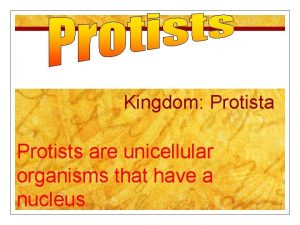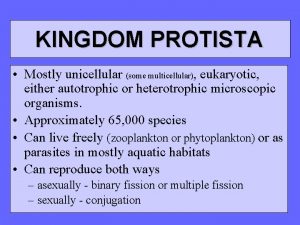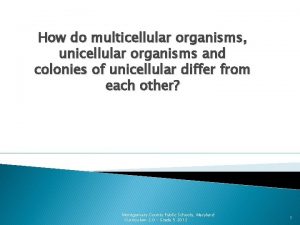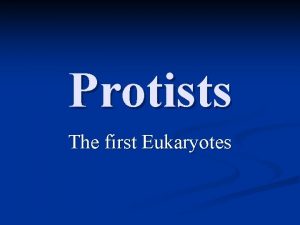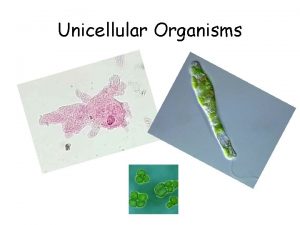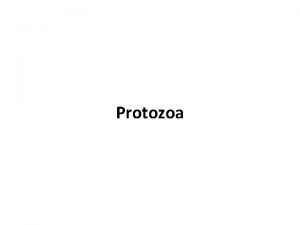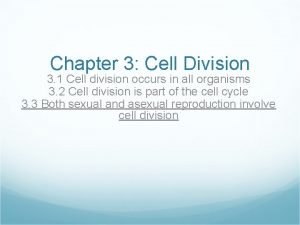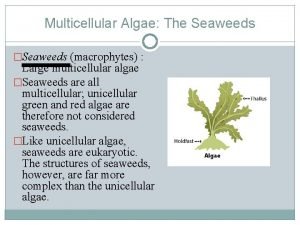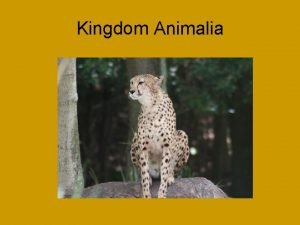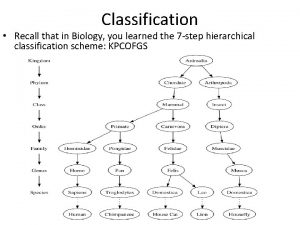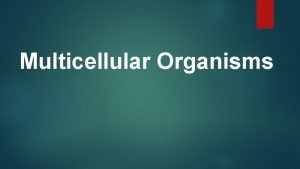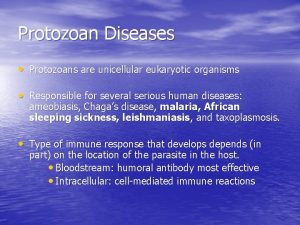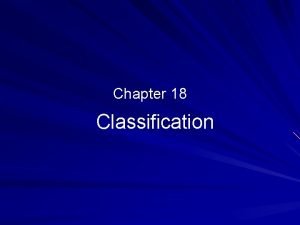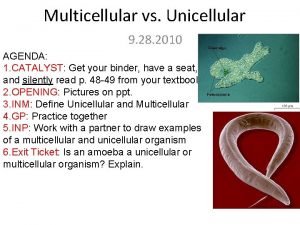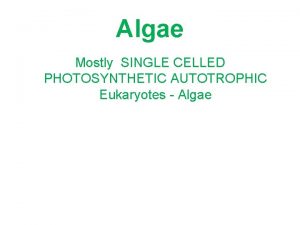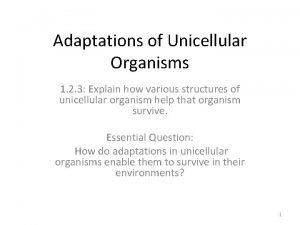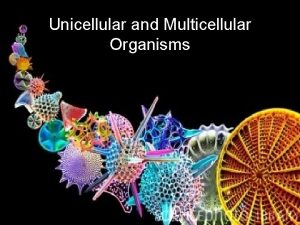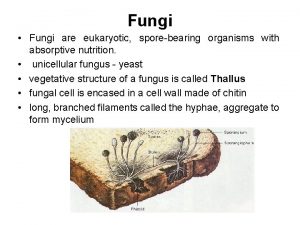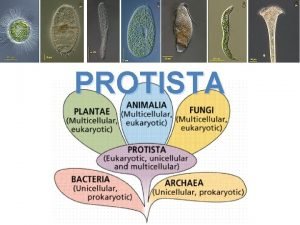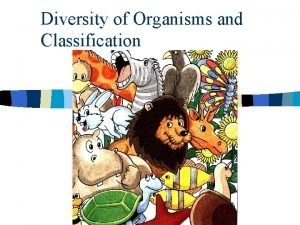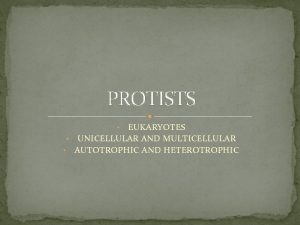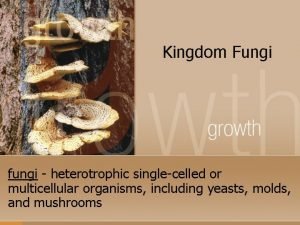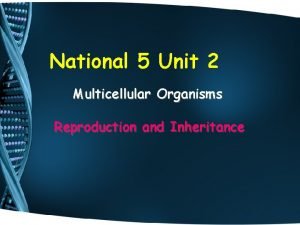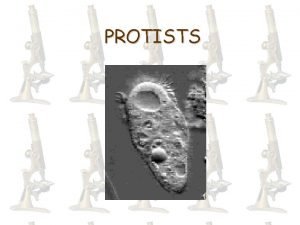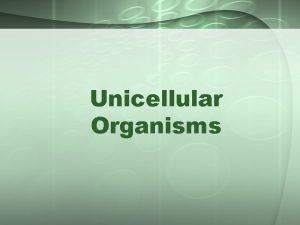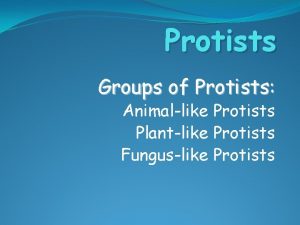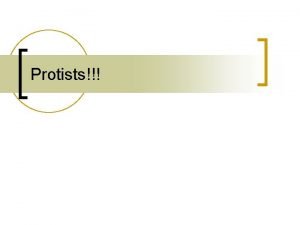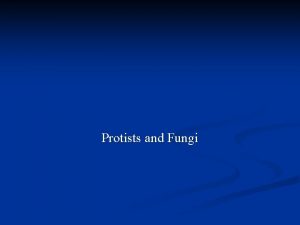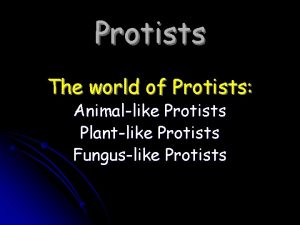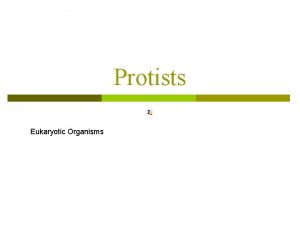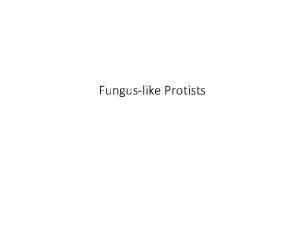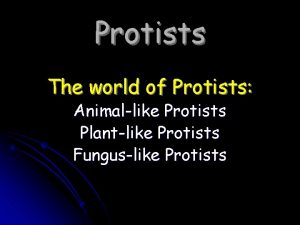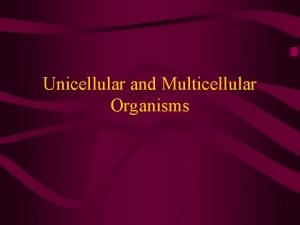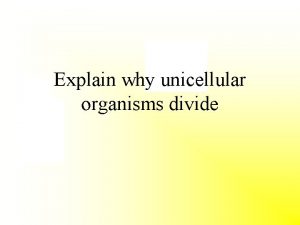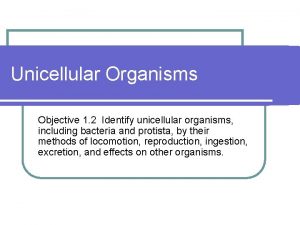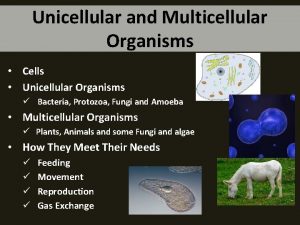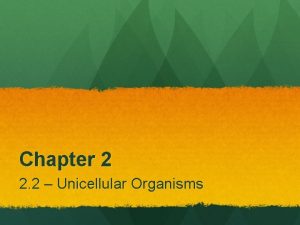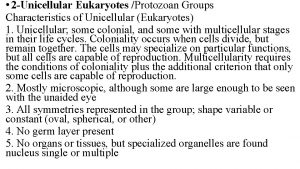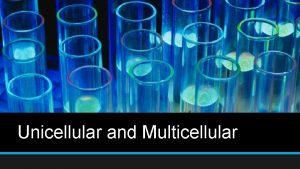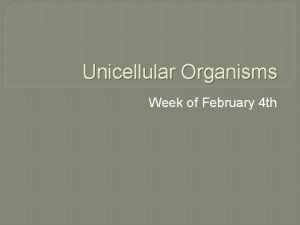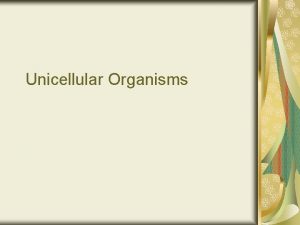PROTISTS What are Protists 1 Protists are unicellular































- Slides: 31

PROTISTS

What are Protists? 1) Protists are unicellular or simple multicellular eukaryotic organisms that are not plants, fungi, or animals.

Ancestry 2) The First Eukaryotes Evidence suggests that the first protists arose from endosymbiotic prokaryotes.

Classification 3) Protists are classified by the characteristics that make them • fungus-like • plant-like or • animal-like

Classification 4) Unicellular and Multicellular Most protists are unicellular, but some form large, multicellular bodies.

Classification 5) Nutrition Many protists are autotrophs, organisms that make their own food. Other protists are heterotrophs, organisms that must get their food by eating other organisms or their byproducts.

Classification 6) Motility Protists use flagella, cilia, or pseudopodia for locomotion. Euglena movement Amoeba movement Paramecium movement

Reproduction 7) Protists reproduce either asexually, or both. They reproduce asexually by binary fission or multiple fission. They often reproduce sexually by conjugation.

ANIMAL-LIKE PROTISTS

ANIMAL-LIKE PROTISTS 1) Animal-like protists resemble animals in the fact that most move and seek out food (heterotrophs). 2) Diversity Animal-like protists include organisms that inhabit the oceans, lakes, soil and even the human intestines.

PHLYUM PROTOZOA 3) Move by means of temporary cytoplasmic projections called pseudopods Pseudopod is Greek for “false foot” 4) The best known protozoan is the Amoeba

PHYLUM CILIOPHORA (Ciliates) Animal-like protists include the phylum Ciliophora. 5) Ciliates move using cilia, which are short, hairlike, cytoplasmic projections that line the cell membrane.

PHYLUM CILIOPHORA (Ciliates) 6) Characteristics Ciliates have the most elaborate organelles, including two types of nuclei. 7) Reproduction Ciliates reproduce asexually by binary fission and sexually by conjugation.

Phylum Zooflagellates Animal-like protists include the phyla Zooflagellates. 8) For locomotion, Zooflagellates use flagella

Phylum Apicomplexa (Sporozoa) 9 -11)Do not move on their own • Most often are parasitic Lives inside a host and uses the host as an energy source. Usually effects the host in a negative way A well known example is the sporozoan Plasmodium, which causes Malaria

PLANT-LIKE PROTISTS

Characteristics of Algae 1) Algae are plant like protists. They can be unicellular, colonial, or multicellular.

Phylum Chlorophyta (Green Algae) 2) Both green algae and plants have: • chlorophylls and accessory pigments • store food as starch • cell walls made up of cellulose. The phylum Chlorophyta contains more than 17, 000 identified species of protists called green algae.

Types of Green Algae 3) Chlamydomonas is a type of unicellular green algae • They use a flagella for movement 4) Spirogyra are long thread like colonies of green algae that are stacked almost like soda cans • Their chloroplast from a spiral structure in which they get their name

Types of Green Algae 5) Volvox - Certainly one of the most spectacular flagellated green algae is Volvox. It forms a spherical colony. All the small cells of the colony possess two flagella and a small eyespot. With this the colony is able to swim towards the light.

Phylum Phaeophyta (Brown Algae) 6) Brown algae are mostly marine organisms, and they include plantlike seaweeds and kelps. The phylum Phaeophyta includes approximately 1, 500 species of multicellular organisms called brown algae. Contain chlorophyll and other brown pigments. The largest know Algae is called giant kelp which is a type of brown algae.

Phylum Rhodophyta (Red Algae) 7) Multicellular organisms that live at great depths of the ocean • Contain chlorophyll and other reddish pigments A few species of red algae live in fresh water or on land, but most red algae are marine seaweeds. The 4, 000 species in the phylum Rhodophyta are known as red algae.

Phylum Bacillariophyta (Diatoms) 8) Diatoms are unicellular protists that produce a thin, delicate cell wall made out of silicon (The main component of glass). The phylum Bacillariophyta contains as many as 100, 000 species of unicellular protists called diatoms.

Phylum Dinoflagellata (Dinoflagellates) 9) Dinoflagellates are microscopic, unicellular, flagellated, and photosynthetic protists. Some species of dinoflagellates, such as those in genus Noctiluca, can produce bioluminescence, a display of sparkling light often seen in ocean water at night.

Phylum Euglenophyta (Euglenoids) 10) Euglenoids are both plantlike and animal-like. Many are autotrophic, like plants, but they lack a cell wall and are highly motile, like animals. Euglenas are characterized by their red eye spot.

Fungus-Like Protists

Fungus-Like Protists 1) Biologists recognize two groups of fungus-like protists: slime molds and water molds. 2 -3) Plasmodial slime molds are multinucleate. As the plasmodium creeps along the forest floor by cytoplasmic streaming, it consumes decaying leaves and other debris by phagocytosis.

Fungus-Like Protists 4) Water Molds Water molds are composed of branching filaments and many of this phylum are parasitic.

Protists in the Environment 5) Protists: • produce large amounts of oxygen • form the foundation of food webs • recycle materials • and play a role in several symbiotic relationships.

Ecology of Protists 6) Algal blooms can lead to the depletion of oxygen in water. Red tides produce harmful toxins.

Protists and Health 7) Parasitic protists cause malaria, giardiasis, cryptosporidiosis, and trichomoniasis in humans. Malaria Parasitic protists in the genus Plasmodium cause malaria, which is characterized by severe chills, headache, fever, and fatigue. Each year, nearly 3 million people die from malaria.
 Antigentest åre
Antigentest åre Protista unicellular or multicellular
Protista unicellular or multicellular Protists are unicellular or multicellular
Protists are unicellular or multicellular Protists are unicellular
Protists are unicellular Protista unicellular or multicellular
Protista unicellular or multicellular Multicellular organism
Multicellular organism A unicellular protist is part of which domain?
A unicellular protist is part of which domain? How are unicellular and multicellular organisms alike
How are unicellular and multicellular organisms alike Verzeala zidurilor
Verzeala zidurilor What is multicellular organism
What is multicellular organism Unicellular heterotrophs
Unicellular heterotrophs L
L Unicellular cell division
Unicellular cell division Angonium
Angonium Characteristics of animalia
Characteristics of animalia Archaebacteria multi or unicellular
Archaebacteria multi or unicellular Unicellular marine organisms
Unicellular marine organisms Unicellular vs multicellular activity
Unicellular vs multicellular activity Protozoans are unicellular
Protozoans are unicellular Finding order in diversity
Finding order in diversity Is bacteria unicellular or multicellular
Is bacteria unicellular or multicellular Is oedogonium unicellular or multicellular
Is oedogonium unicellular or multicellular Is a nerve cell multicellular or unicellular
Is a nerve cell multicellular or unicellular Unicellular organism
Unicellular organism Diatoms unicellular or multicellular
Diatoms unicellular or multicellular Fungi are eukaryotic
Fungi are eukaryotic What kingdom is photosynthetic aquatic and unicellular
What kingdom is photosynthetic aquatic and unicellular The smallest grouping that can interbreed.
The smallest grouping that can interbreed. Give an example for unicellular organism
Give an example for unicellular organism Are protists heterotrophic or autotrophic
Are protists heterotrophic or autotrophic Kingdom fungi unicellular or multicellular
Kingdom fungi unicellular or multicellular Are pollen grains multicellular or unicellular
Are pollen grains multicellular or unicellular



